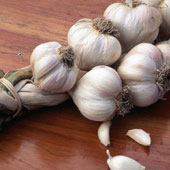
© Steven Foster
On this page:
- Introduction
- What It Is Used For
- How It Is Used
- What the Science Says
- Side Effects and Cautions
- Sources
- For More Information
Introduction
This fact sheet provides basic information about garlic—uses, potential side effects, and resources for more information. Garlic is the edible bulb from a plant in the lily family. It has been used as both a medicine and a spice for thousands of years.
Common Names—garlic
Latin Names—Allium sativum
What It Is Used For
- Garlic's most common uses as a dietary supplement, product that contains vitamins, minerals, herbs or other botanicals, amino acids, enzymes, and/or other ingredients intended to supplement the diet. The U.S. Food and Drug Administration has special labeling requirements for dietary supplements. are for high cholesterol, heart disease, and high blood pressure.
- Garlic is also used to prevent certain types of cancer, including stomach and colon cancers.
How It Is Used
Garlic cloves can be eaten raw or cooked. They may also be dried or powdered and used in tablets and capsules. Raw garlic cloves can be used to make oils and liquid extracts.
What the Science Says
- Some evidence indicates that taking garlic can slightly lower blood cholesterol levels; studies have shown positive effects for short-term (1 to 3 months) use. However, an NCCAM-funded study on the safety and effectiveness of three garlic preparations (fresh garlic, dried powdered garlic tablets, and aged garlic extract tablets) for lowering blood cholesterol levels found no effect.
- Preliminary research suggests that taking garlic may slow the development of atherosclerosis (hardening of the arteries), a condition that can lead to heart disease or stroke.
- Evidence is mixed on whether taking garlic can slightly lower blood pressure.
- Some studies suggest consuming garlic as a regular part of the diet may lower the risk of certain cancers. However, no clinical trials have examined this. A clinical trial on the long-term use of garlic supplements to prevent stomach cancer found no effect.
- Recent NCCAM-funded research includes studies on how garlic interacts with certain drugs and how it can thin the blood.
Side Effects and Cautions
- Garlic appears to be safe for most adults.
- Side effects include breath and body odor, heartburn, upset stomach, and allergic reactions. These side effects are more common with raw garlic.
- Garlic can thin the blood (reduce the ability of blood to clot) in a manner similar to aspirin. This effect may be a problem during or after surgery. Use garlic with caution if you are planning to have surgery or dental work, or if you have a bleeding disorder. A cautious approach is to avoid garlic in your diet or as a supplement for at least 1 week before surgery.
- Garlic has been found to interfere with the effectiveness of saquinavir, a drug used to treat HIV infection. Its effect on other drugs has not been well studied.
- Tell your health care providers about any complementary and alternative practices you use. Give them a full picture of what you do to manage your health. This will help ensure coordinated and safe care.
Sources
- Gardner CD, Lawson LD, Block E, et al. Effect of raw garlic vs. commercial garlic supplements on plasma lipid concentrations in adults with moderate hypercholesterolemia: a randomized clinical trial. Archives of Internal Medicine. 2007;167(4):346–353.
- National Cancer Institute. Garlic and Cancer Prevention: Questions and Answers. National Cancer Institute Web site. Accessed at cancer.gov/newscenter/pressreleases/garlic on July 9, 2007.
- Agency for Healthcare Research and Quality. Garlic: Effects on Cardiovascular Risks and Disease, Protective Effects Against Cancer, and Clinical Adverse Effects. Accessed at ahrq.gov/clinic/epcsums/garlicsum.htm on July 9, 2007.
- Garlic. Natural Medicines Comprehensive Database Web site. Accessed July 3, 2007.
- Garlic (Allium sativum L.). Natural Standard Database Web site. Accessed June 28, 2007.
- Garlic. In: Blumenthal M, Goldberg A, Brinckman J, eds. Herbal Medicine: Expanded Commission E Monographs. Newton, MA: Lippincott Williams & Wilkins; 2000:139–148.
- Milner JA. Garlic (Allium sativum). In: Coates P, Blackman M, Cragg G, et al., eds. Encyclopedia of Dietary Supplements. New York: NY: Marcel Dekker; 2005:229–240.
NCCAM Clearinghouse
The NCCAM Clearinghouse provides information on CAM and NCCAM, including publications and searches of Federal databases of scientific and medical literature. The Clearinghouse does not provide medical advice, treatment recommendations, or referrals to practitioners.
Toll-free in the U.S.: 1-888-644-6226
TTY (for deaf and hard-of-hearing callers): 1-866-464-3615
Web site: nccam.nih.gov
E-mail: info@nccam.nih.gov CAM on PubMed
Web site: nccam.nih.gov/camonpubmed/
NIH Office of Dietary Supplements
Web site: ods.od.nih.gov
NIH National Library of Medicine's MedlinePlus
Garlic Listing: www.nlm.nih.gov/medlineplus/druginfo/natural/patient-garlic.html
This publication is not copyrighted and is in the public domain. Duplication is encouraged.
NCCAM has provided this material for your information. It is not intended to substitute for the medical expertise and advice of your primary health care provider. We encourage you to discuss any decisions about treatment or care with your health care provider. The mention of any product, service, or therapy is not an endorsement by NCCAM.
NCCAM Publication No. D274
Created May 2006
Updated March 2008
Information Provided By:
NCCAM
National Institutes of Health
9000 Rockville Pike
Bethesda, Maryland 20892 USA
E-mail: info@nccam.nih.gov